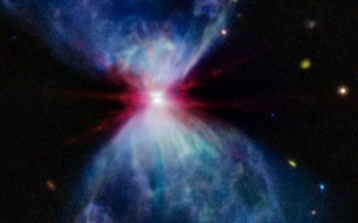The James Webb Space Telescope (JWST) has captured a stunning celestial display resembling fireworks around a forming star, showcasing the telescope’s remarkable capabilities in observing cosmic phenomena. This vibrant image, obtained using Webb’s Mid-Infrared Instrument (MIRI), features a fiery hourglass-shaped nebula around a central protostar which is in the early stages of star formation.
Located in the molecular cloud L1527, within the Taurus star-forming region, this young protostar is about 100,000 years old and is still gathering material from its surrounding environment. The protostar, seen in the neck of the hourglass, is actively pulling in material from a thin protoplanetary disk, which is visible edge-on as a dark line across the star.
Webb’s MIRI and NIRCam (Near-Infrared Camera) instruments have provided complementary views of this dynamic scene. MIRI, observing in mid-infrared, reveals how energetic outflows from the protostar impact the dense molecular cloud around it. These outflows, shooting out along the star’s rotation axis, generate bow shocks that light up the nebula, creating the bright, hourglass figure visible in the image. These movements are indicative of the protostar’s consumption of gas and dust, which fuels its growth but also carves out and energizes the surrounding material.
In a breathtaking first, the James Webb Space Telescope has captured a phenomenon astronomers have long yearned to see. Jets of gas from newborn #stars, elegantly aligned like celestial arrows, defy cosmic norms. #StellarBirths #JamesWebbTelescope pic.twitter.com/xhocUP5TY6
— Jay Dungrani (@iamjaydungrani) June 27, 2024
The image colors capture different elements of the nebula: blue areas predominantly show polycyclic aromatic hydrocarbons, a type of carbonaceous molecule, while red regions depict dense dust and gases enveloping the protostar. White areas near the protostar represent a mix of hydrocarbons, ionized neon, and thick dust, illustrating the turbulent interaction of these materials as the star forms.
The study of mysterious celestial objects discovered by the James Webb Space Telescope reveals the identification of luminous objects within the time span of 600 to 800 million years after the Big Bang.https://t.co/5LtImhuWxb
— Khaama Press (KP) (@khaama) July 1, 2024
As the protostar matures, it will continue to exert forces on its parental cloud, propelling material away and altering the cloud’s structure. Over time, these actions will cause the current vivid features to fade as the protostar evolves into a full-fledged star, eventually becoming visible to even conventional telescopes.
The JWST, launched on December 25, 2021, is designed for infrared astronomy and is equipped to study the universe in unprecedented detail. As the successor to the Hubble Space Telescope, it can observe the formation of the earliest galaxies and stars, examine the atmospheres of distant exoplanets, and explore star and galaxy formation processes in depth.
James Webb Space Telescope celebrates Independence Day by showcasing dazzling ‘cosmic fireworks’ 460 light-years away https://t.co/WEBB8BXLFb
— How It Works (@HowItWorksmag) July 4, 2024
This latest observation from the JWST not only highlights the dynamic processes involved in star formation but also emphasizes the telescope’s role in enhancing our understanding of the universe’s earliest developmental stages.
Key Points:
i. The James Webb Space Telescope captured a stunning image of celestial fireworks around a forming star in the molecular cloud L1527, using its Mid-Infrared Instrument (MIRI).
ii. The image features a protostar about 100,000 years old at the center of a brightly lit hourglass-shaped nebula, illustrating the star’s early formation stages.
iii. MIRI’s observations reveal energetic outflows from the protostar impacting the surrounding molecular cloud, creating bow shocks that illuminate the nebula.
iv. The different colors in the image indicate various materials, with blue showing carbonaceous molecules, red depicting dense dust and gases, and white areas representing a mix of hydrocarbons, ionized neon, and dust.
v. As the protostar matures, it will continue to affect its surrounding cloud, ultimately leading to the fading of these vivid features as it evolves into a fully formed star visible to conventional telescopes.
Conner T – Reprinted with permission of Whatfinger News



